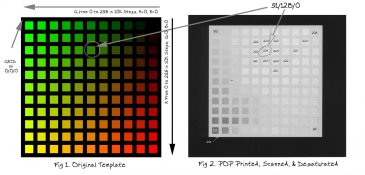I'm not an expert by any stretch of the imagin
In that case:
The reason for using a color negative is to increase/maximize the UV opacity (if needed for a given process) since for many printers, the UV-densest ink paradoxically is not the black but some other color that is unique for a given printer/ink combo.
:Niranjan
The maximum UV opacity is determined by the printer/ink set and it's exactly the same for grayscale and color.
For example, on my printer, the maximum density I can produce with a grayscale negative is 2.10. I can't increase it to 2.15 with a color negative, because the darkest (densest) color for any color is black.
If you plot densities for red, green, blue, and grayscale negatives, all four curves start at the same density and end at the same density. But betwen the endpoints, the curves have very different shapes. So I think at least some of the arguments favoring color have to do with the intermediate shapes of the density curves. What do you think?
https://photos.app.goo.gl/JvntDurAjrZWeaTXA







